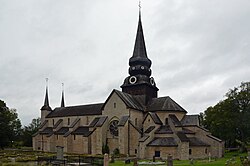Varnhem Monastery
| Varnhem Cistercian Abbey | |
|---|---|
 Varnhem Monastery Church |
|
| location |
Sweden Västra Götalands län |
| Coordinates: | 58 ° 23 '3 " N , 13 ° 39' 15" E |
| Serial number according to Janauschek |
307 |
| founding year | 1150 |
| Year of dissolution / annulment |
1529 |
| Mother monastery | Alvastra Monastery |
| Primary Abbey | Clairvaux Monastery |
The monastery church Varnhem , located in Varnhem between the towns of Skara and Skövde in the Swedish province of Västergötland , is the grave church of Erik's medieval royal dynasty ( Knut Eriksson and Erik Knutsson , Erik Eriksson ) as well as the progenitor of the Folk dynasty Birger Jarl and the imperial chancellor Magnus Gabriel de la Gardie .
Varnhem Monastery was founded by the Cistercians in 1150 as the daughter of Alvastra Monastery , which in turn was a daughter of Clairvaux Primary Abbey . The monks became a few years later, in 1158, by Queen Kristina, wife of Erik IX. and mother of Knut l. Eriksson, expelled from Varnhem. According to the Narratiuncula de fundatione monasterij Vitaescholae in Cimbria , written in 1409, Vitskøl Monastery in Denmark is said to have been founded from Varnhem. After their return to Varnhem, they were supported by the Erik family.
The monastery church, originally built in Romanesque style, was badly damaged in a fire in 1234. It was rebuilt in the early Gothic style based on the model of the churches of Clairvaux ( France ) (Clairvaux II, with a choir) and Marienfeld ( Germany ). The choir was enlarged by a semicircular ambulatory with a chapel wreath. After the Reformation the monastery was abandoned and withdrawn from the crown; the monastery and church fell into disrepair.
In the middle of the 17th century, the Swedish Chancellor Magnus Gabriel de la Gardie (1622–1686), whose county Läckö was not far from Varnhem, visited the church. He recognized the value of the church as a former royal burial church and had it renovated as it was to house his own tomb (and that of his family). At that time it was redesigned, and the west facade with the spiers and the roof turret over the center of the cross were recreated. In 1673 the work was so far finished that the church could be consecrated again.
Between 1918 and 1923 the church was renovated again. At the same time, the foundation walls of the monastery buildings were excavated. These excavations resumed in the 1970s and are now open to the public. Other finds can be viewed in the monastery museum next to the church.
After the Swedish author Jan Guillou had made the monastery an important location in the historical novels of his Götaland trilogy (1998-2000), tourism increased sharply. A pilgrimage route leads to the monastery and to other neighboring locations in the trilogy. Further excavations in 2005–2008 uncovered a room that is considered to be the oldest Christian sacred space in Sweden and sheds new light on the early history of Christianization. Since 2017 it has been shown to the public - under a specially constructed roof structure.
Nearby is Lilla Lycke's burial ground .